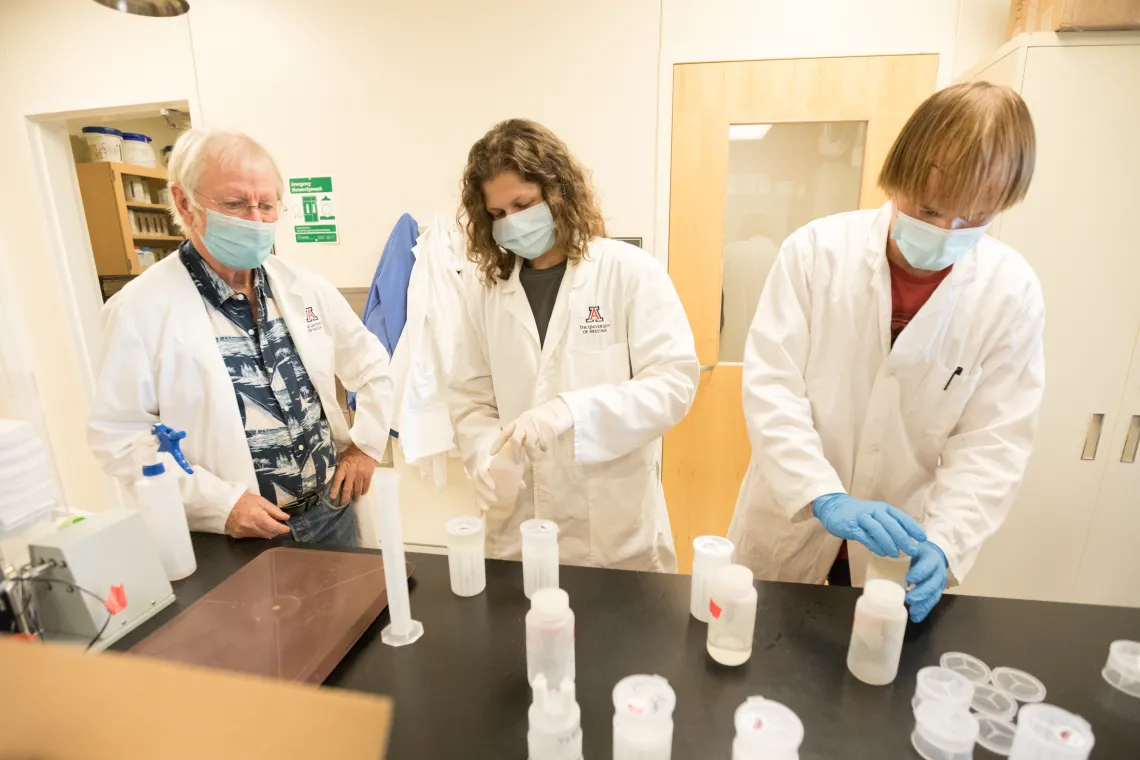Omicron and other variants detectable in wastewater

Photo credit: UA and Chris Richards
Wastewater-based epidemiology (WBE) at WEST Center
As one of the first laboratories in the United States to track COVID-19 using SARS-CoV-2 viral concentrations in wastewater, WEST Center has monitored pandemic conditions since early 2020. WEST researchers originally provided wastewater analysis for water reclamation facilities (WRFs) from around the country, and in the past year and a half, the Center has actively monitored University of Arizona student dormitories to identify potential hot spots. Dorm wastewater testing positive for SARS-CoV-2 viral RNA results in targeted clinical testing which reduces exponential spread of the virus. This work has been recognized as vital to managing local pandemic conditions and allowing the University to remain open.
As the pandemic evolves, so too have analytical capabilities at WEST Center. Of special concern in recent months is the spread of variants and their potential impact on health and vaccine efficacy. To respond to this new concern, two new digital polymerase chain reaction (dPCR) instruments were installed at WEST Center in August 2021. These instruments allow for the rapid and sensitive detection of SARS-CoV-2 and variants in wastewater.
Omicron
On November 24, 2021, a new variant was reported to the World Health Organization (WHO) which was first detected in Botswana and South Africa. In the remaining days of November, the new variant was named B.1.1.529 Omicron and was designated as a Variant of Concern by WHO and the United States CDC. According to an NPR news piece, traces of Omicron were detected in wastewater in Houston, TX, Boulder, CO, and two cities in Northern California during the first weeks of December 2021. Testing of wastewater to provide early detection of the virus also suggests that Omicron is present in many other cities in the U.S. (short news list below).
At WEST Center, wastewater can be screened for Omicron, Delta, and other variants to provide presumptive detection of SARS-CoV-2 strains prior to confirmatory sequencing. With respect to laboratory detection of the Omicron variant, wastewater samples are concentrated and then analyzed for the variant using the dPCR instrument. The Omicron variant shares key genomic structures with previous variants (now displaced from circulation); therefore, existing PCR assays can be used to rapidly identify the likely presence of the new variant. Detection of both the N501Y mutation and 69-70 deletion are indicators of presumptive Omicron in the community.
There is an urgent need to monitor the spread of variants to manage public health preparedness and response, and WBE has proven to be an exemplary tool for the task. It offers a more complete picture of SARS-CoV-2 status in a community than clinical testing alone; it captures individuals who are asymptomatic and those who don’t get tested or self-test. The strategy also provides early detection of SARS-CoV-2 and can provide advance notice of variants presence/predominance within a population.
For more information, contact Ian Pepper at ipepper@email.arizona.edu.
Short news list
Dillon, Raquel Maria. Poop sleuths hunt for early signs of omicron in sewage. KQED/NPR (Dec. 9, 2021).
Lin II, Rong-Gong and Money, Luke. Signs of Omicron found in California wastewater, suggesting variant is widespread. Los Angeles Times (Dec. 9, 2021).
Levkulich, Jeff; DeMarco, Jack; and Navarro, Chantelle. Seminole County extending COVID-19 vaccine events after omicron variant detected in wastewater. WFTV/ABC (Dec. 13, 2021).
Robins-Early, Nick. Sewage water testing provides clues to Omicron spread across US. The Guardian (Dec. 10, 2021).

